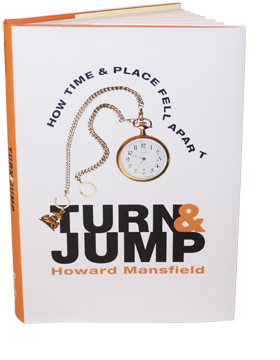TURN & JUMP: HOW TIME AND PLACE FELL APART
Down East Books/Rowman & Littlefield
Before the railroads required the creation of Standard Time zones in 1883, timekeeping was a local affair. Small towns set their own pace according to the rising and setting of the sun. Our sudden interconnectedness, both physically and through inventions like the telegraph, changed our concept of time and place forever.
Here, historic preservationist Howard Mansfield looks at a few of the “clocks” we carry. He explores time in a once-common, now-vanished dry-goods store; in the invention of Continuous Vaudeville; in an old mill family defending water rights; in an 1880s Broadway hit that is still performed annually; and in the lingering effects of a bloody war that one historian calls the first American Revolution—a war many Americans don’t even know happened.
“Timekeeping changed in two important ways in the last quarter of the 19th Century and the early years of the 20th Century,” Mansfield writes. “Clocks became more accurate and were linked to each other. Time reformers spoke of linking all clocks on earth to one master clock. At the same moment, time escaped out the front door.”
The title Turn & Jump is a vaudevillian phrase that refers to actors who would take their “turn” on stage and “jump” to the next city soon after. “The language has the feel of rough travel over badly maintained railway track,” writes Mansfield. “Business travelers live this life today…that’s the cadence of many lives.”
To Mansfield, it makes sense that the man who sold the “endless match” would also invent Continuous Vaudeville. Benjamin Keith, an orphaned New England farm boy, was a peddler turned theater owner. One of his most successful products was a match that would furnish 10,000 lights for a cigar. He later purchased a theater and realized that keeping seats occupied with an endless variety show was “like an endless match,” says Mansfield. “Keith would just have to strike a light once—attract that initial audience—and he could keep his theater going.” He became a millionaire, one of the first ever in show business.
“With ‘the Continuous,’ Keith had found the pulse of the American city,” Mansfield writes. “Industrial production was continuous; democracy was a continuous cycle of election-scandal-election.”
The pulse of business was made continuous with the invention of the Limited Liability Corporation in the late 19th Century, securing an “afterlife” for companies, writes Mansfield. In New England, the legacy of these corporations is evident in the control of water rights—the power to control levels of the lakes and ponds created by the system of dams supporting the area’s now closed woolen mills. The owners of today’s waterfront homes are often unaware that their property values are dependent upon the of dams built for industry.
“Waterpower moved to village time, to agricultural time,” Mansfield writes. “But the tempo of American life had changed after the Civil War. Modern times demanded steady production and large operations.” He finds that the legacy is two different timekeepers in the same place. “Waterpower wrenched time and place once,” he continues, “and leisure power wrenches it again. Time is shaping the maps here. The industrial time that shaped the land is invisible to the summer people.”
In Mansfield’s hands, the diary of a local dry goods merchant becomes, “an uncanny history of the ordinary…a documentary about the soul of a store.” Every 20th century transition was reflected in Derby’s of Peterborough, New Hampshire, as it evolved from a dry goods store to a self-service grocery into a full-fledged department store during its 103-year history. “The Derby’s store is all change—it’s a continuous performance,” he writes.
Derby’s closed in 1985—the store where everyone knew you and your needs was no more. Today, Mansfield says, “we choose mobility over community. We choose freedom to be unknown. We want anonymous public space. At the mall we are released from time. The mall is a cleaned clock. A mall displaces time with mall time.”
In nearby Swanzey, a revival of the 1887 play The Old Homestead has been playing continuously in an outdoor theater every summer since 1939. Like Derby’s, says Mansfield, “the play is a catalog of lost life. Its slow pace was the real story. Look at how slowly time used to pass. We had time to chat. We were barefoot. We did chores.”
A generic listing on a war monument—“The Colonial Wars 1675-1763”—takes Mansfield to the town of Turners Falls, a Massachusetts mill town fallen on hard times. “It feels like something terrible has happened here,” he writes. “I sense so many notes of anguish.” The surprise, though, is that the anguish is not derived from the closing of the mills. Rather, Turners Falls is the site of a significant battle in the “Colonial Wars.” On May 19, 1676, 400 Native Americans, gathered for an annual fishing ritual, were murdered by British settlers. The English settled the land, and the memory never fully put to rest.
“I think there is a resonance where terrible things happen,” a Native American descendent explains. “The landscape remembers. It’s not just human memory. I think there’s some kind of vibe (for lack of a better word) that just holds on. It permeates the place.” Today, the town has high rates of poverty, suicide, and spouse abuse. Turners Falls High School is the “Home of the Indians,” but most people who live in this place have no idea of its tragic history.
“Turner’s Falls is divorced from deep time, from the land’s true history,” Mansfield concludes. “For thousands of years this place kept time by the salmon leaping the falls and the Indians gathering to fish. In an instant, on one Spring morning in 1676, that ended. In another instant, the falls were dammed; the salmon were gone. The river’s run has changed; time has changed. The Indian heritage is denied. What I had felt on my first visit was the pain of divorce.”

